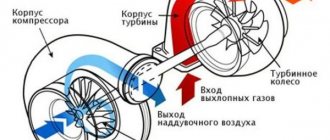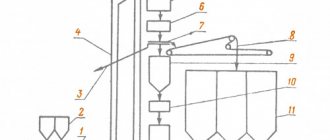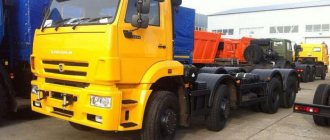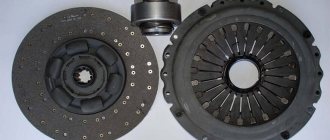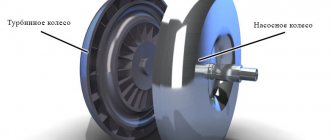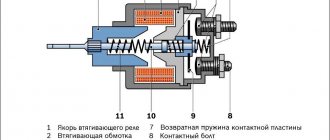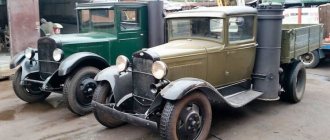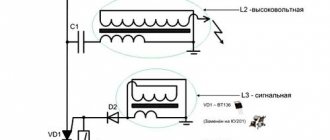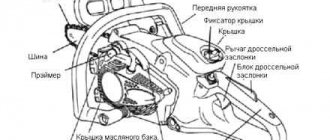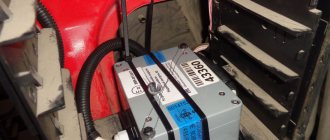The type of fuel that is used in a vehicle is the basis around which everything revolves. Engines, fuel systems, pumps and filters were developed for a specific class of combustible material: kerosene, oil, gasoline, diesel fuel, oil, etc. In the history of engineering inventions, there was practically no case where chemists invented a new type of fuel for a specific mechanical basis.
This principle also applies when comparing two components that are part of the car’s power unit: the turbine. For diesel and gasoline engines, components that perform the same function, have external structural similarities and practically the same set of main components will turn out to be completely different.
Differences between gasoline and diesel turbines
The main difference between the main components of the turbocharger is the use of different materials for the impeller and housing. But only an experienced turbine mechanic with extensive experience can determine by appearance what type of fuel a particular turbine is intended for.
Turbine blades , regardless of which engine it is installed on, are driven by the flow of exhaust gas. In diesel engines, after combustion of diesel fuel, the gas temperature at the outlet does not exceed 850 o C , but diesel fuel can continue to burn at the exit to the exhaust manifold. , the exhaust gas temperature does not fall below 1000 o C.
Based on such a difference in the temperature of the gas that will spin the turbine wheel, the body and blades of the unit must be made of different materials.
For the turbine impeller, heat-resistant nickel-containing metals are used: GMR 235 (used for the impeller at an outlet flow temperature of 850 o C), Inconel 713 (the chromium content in the metal is increased, used for the impeller of a gasoline turbine, the material is designed to pass the outlet gas at temperatures up to 1000 o C ).
The housing material for diesel turbines is gray cast iron (maximum operating temperature - 650 o C), silicon-molybdenum cast iron (maximum operating temperature - 720 o C), cast iron with vermicular graphite GGV SiMo (max. t. - 850 o C) .
For the casing of turbines built into a gasoline engine, heat-resistant alloys are used that can withstand long-term temperatures of more than 1000 o C (austenitic steels, NiResist 5 alloy).
The second difference in the turbine material is that gasoline turbines are designed for the minimum pressure exerted by spent gasoline vapor in the exhaust manifold. Gases from spent diesel fuel have a pressure 3-5 times higher .
The main conclusion follows from this: it is impossible to install a gasoline turbine on a diesel engine and vice versa. This will cause detonation and reduce the efficiency of each engine. In addition, for gasoline turbines, a compressor design with variable geometry . Technological solutions VNT, VTG, VGT are not adapted to the high exhaust temperatures produced by a gasoline engine. Therefore, a gasoline turbine has only the main parts in its design.
Types of exhaust manifolds and their influence
Basically, all turbo manifolds are divided into two types: cast log-style and welded pipe: The design of a turbo manifold is a rather complex process because a lot of factors must be taken into account. Below are general tips for achieving maximum performance: - Try to use the largest possible turning radius as how each sharp bend of the runner absorbs part of the useful energy of the gas flows. — Achieve equal length of runners to avoid cross-exhaust pulses. — Avoid sudden changes in cross-section — Avoid sharp angles in runner arches to maintain flow direction and speed — For better turbine response, avoid large collector volumes, for higher peak power, on the contrary, a larger collector volume can be used — Optimally select the length of the runners and the collector volume in depending on the engine size and the speed range at which it is necessary to obtain the best performance. Cast manifolds are most often used in factory civil configurations, while welded pipe manifolds are more often used in sports versions of engines. Both types have their advantages and disadvantages. Cast manifolds are usually quite compact and cheaper to mass produce. Pipe manifolds can be manufactured in small series or single copies for a specific case and do not require such complex preliminary production organization as cast ones. A properly designed and manufactured tube manifold will provide long service life and significant performance improvements over a cast log-style manifold.
Features of a diesel turbine
A diesel turbine, like a gasoline turbine, belongs to the mounted engine unit. The turbocharger cuts into the exhaust manifold system and uses all engine systems for its operation: cooling and lubrication, crankcase ventilation, exhaust gas intake and exhaust.
The turbine forces air into the fuel cylinders at high pressure. The turbine rotor spins, passing the energy of the spent fuel through itself, and sets the supercharger blades in motion - air is sucked from the atmosphere, compressed and supplied to the cylinder block. The rotation speed of the turbine rotor on some diesel engines can reach up to 250,000 rpm - this figure is considered normal, but for some turbochargers this is the limit of acceptable capabilities.
Structurally, the turbine consists of two blocks: a turbine wheel and a compressor wheel. Since wheels have blades, their second name is impellers . Both blocks are fixed on the rotor shaft. Main parts of a diesel turbine:
- turbocharger impeller (included in the hot snail unit); • compressor impeller (cold scroll block); • bearing block; • turbine housing; • rotor shaft.
Blow-off
A blowoff valve is a device installed in the air system between the compressor outlet and the throttle valve to prevent the compressor from entering surge mode. At moments when the throttle closes sharply, the flow rate and air flow in the system drops sharply, while the turbine continues to rotate for some time by inertia at a speed that does not correspond to the new dropped air flow. This causes cyclic pressure surges behind the compressor and an audible characteristic sound of air rushing through the compressor. Surge eventually leads to failure of the turbine support bearings due to the significant load on them in these transient conditions. BlowOff uses a combination of manifold pressure and manifold spring to determine when the throttle closes. In the event of a sharp closing of the throttle, the blowoff releases the excess pressure arising in the air path into the atmosphere and thereby saves the turbocharger from damage.
Features of the turbine block as the main element of the supercharger
A hot snail passes a stream of exhaust gases through itself at a high temperature. Passing through the cochlea, the gases accelerate and set the rotor shaft in motion, then are thrown out through the outlet valve. The rotation speed of the turbine depends on the engine speed - at idle speed the turbine is practically not used.
Each design type of diesel turbine uses a different number of channels for the passage of spent fuel, using an electronic flow control system through variable geometry.
Twin scroll manifolds
The twin-wheel manifold can be either cast or welded pipe and is used in conjunction with the corresponding twin-sky turbine housing. The purpose of this design is to separate the cylinders, whose operating cycles can intersect with each other, and to better utilize the exhaust impulse of each cylinder. For example, on a 4-cylinder engine with a cylinder firing order of 1-3-4-2, cylinder #1 begins its exhaust phase while the exhaust phase in cylinder #2 is not yet completed, and its exhaust valve is open, and depending on the amount of overlap , at this moment the intake valve of cylinder #2 may also be open. In a non-twinscroll manifold, a high pressure pulse from cylinder #1, entering the manifold, disrupts the flow of cylinder #2, preventing it from being properly purged in its initial intake stage. Also, at the same time, the flow from cylinder #1 itself loses part of its energy. The correct layout for a twin scroll manifold, in this case, would be to group cylinders #1 and #4 in one half of the manifold, and cylinders #2 and #3 in the other. An example of twin-scroll turbine housing: More efficient use of exhaust gas energy in twin-scroll systems leads to improved turbine responsiveness at low speeds and more power at high speeds.
Compressor block
The part of the turbine through which atmospheric air is forced is called a compressor. Main components: housing (cold volute), rotor. The rotor is rigidly mounted on a common axis with the turbine impeller. When the first one rotates, the rotor wheel moves in the opposite direction. Due to the rotation of the aluminum rotor blades, the air is drawn in by a vortex flow, the air pressure increases due to the flow transition from the center of the rotor to its walls.
Double turbine is used on multi-cylinder blocks
An air filter installed at the inlet to the intake manifold prevents dirt, small debris, etc. from entering the turbine.
The term Trim.
Trim is a common term used to describe the turbine or compressor wheel of a turbine. For example, you might often hear the phrase I have a GT2871R turbine with 56 Trim. So what is it? Trim is a value that shows the relationship between the inducer and exducer of a turbine or compressor wheel. Even more precisely, this is the ratio of their areas. The diameter of the inducer is the diameter of the impeller wheel in the part where the air enters the impeller, and the exducer is the diameter of the wheel where the air leaves it. The design of the turbine is such that the inducer of the compressor wheel is smaller than its exducer, and the opposite is true for the turbine: For example: The GT2871R turbine (Garrett part number 743347-2) has a compressor wheel with: Inducer diameter: 53.1mm Exducer diameter: 71.0mm Thus Trim for it will be: The trim of the impeller, both the compressor and the turbine, directly affects its performance. The higher the trim value, the more air flow can generally pass through the impeller.
Turbine axis design
In the central part of the turbocharger there is an axial block with bearing assemblies (radial, plain bearings, thrust), which uses the engine oil system. In order for the rotor to rotate at the maximum frequency for the maximum amount of time, it is necessary to provide an oil wedge between the shaft and bearings to avoid direct friction of the parts, which are pressed against each other as much as possible during operation. If the turbine uses an uncooled casing system, the lubricant will also ensure heat removal from the hot scroll assembly and shaft.
The first malfunction that occurs when repairing turbines is the operation of the unit “dry”, when the parts rotate in poor lubrication mode. In this case, traces of overheating and “discoloration” appear on the turbine housing, parts wear out quickly, and rapid coking of the crankcase, oil tube and all turbine components occurs.
Myths about the oil filter
The size of the oil filter on the rally Peugeot 205 t16 group B is indicative.
Let us dispel the misconception of some motorists who say that timely replacement of the oil filter will prevent wear of the moving parts of the turbine. At the moment of a cold start, and also when the oil filter is clogged to its critical level, the filter safety valve opens slightly, and some of the oil always penetrates into the turbine system, as well as into the oil system of the entire power unit. The valve will remain half-open or fully open until the oil reaches its normal temperature. Thus, all foreign particles and suspensions that are in the oil will sooner or later end up in the turbine.
Features of a gasoline turbine
The operating principle of a turbocharger for a gasoline engine is no different from a diesel engine - the same circuit is used here. The spent gasoline passes into the exhaust manifold, into which a hot snail pipe with a paddle wheel located in the central side is embedded. The exhaust gases spin the turbine wheel, which transmits the rotational force along the axis to the compressor wheel. Exhaust gases are discharged outside. Due to the rotation of the rotor, atmospheric air is pumped into the cold snail, which enters the engine cylinders. The fuel begins to burn more intensely and the engine speed increases.
Many motorists who install a turbine on the gasoline engines of their cars or purchase a factory equipped turbocharger, in addition to the joy that the engine has increased power by 20-30%, the torque plateau is quite flat in a larger speed range, the exhaust gases fall under the Euro5 protocol , note great difficulties in operating the car.
The effect of complete combustion of fuel and savings at refueling is offset by the high demands of the power unit on the quality of gasoline, and, most importantly, oil, the range of which is limited for turbocharged gasoline engines. The oil filter will need to be changed after 5-6 thousand kilometers.
In addition, a gasoline turbine is three times more likely than a diesel turbine to cause detonation . This is due to poor fuel quality and a malfunction of the intercooler (air cooler).
Although manufacturers claim the service life of a turbine is within the service life of the “native” engine, in practice a diesel turbine lasts 30-45% of the engine’s service life, a gasoline turbine - 15-25%.
About the history of the invention and implementation of turbocharging
So, the idea of “putting into action” the energy of exhaust gases appeared soon after the invention and successful experiments in the use of internal combustion engines. German engineers and pioneers of automobile and tractor construction, led by Diesel and Daimler, conducted the first experiments in increasing engine power and reducing fuel consumption by pumping compressed air from exhausts.
Gottdieb Daimler produced cars like this, and was already thinking about introducing a turbocharging system
But the first to build the first efficient turbocharger was not them, but another engineer, Alfred Büchi. In 1911, he received a patent for his invention. The first turbines were such that it was possible and advisable to use them only on large engines (for example, ships).
Next, turbochargers began to be used in the aviation industry. Beginning in the 1930s, the United States regularly launched military aircraft (both fighters and bombers) with gasoline engines equipped with turbochargers. And the first truck in history with a turbocharged diesel engine was made in 1938.
In the 60s, the General Motors Corporation produced the first Chevrolet and Oldsmobile passenger cars with turbocharged gasoline carburetor engines. The reliability of those turbines was poor, and they quickly disappeared from the market.
1962 Oldsmobile Jetfire - the first turbocharged production car
The fashion for turbocharged engines returned at the turn of the 70s/80s, when turbocharging began to be widely used in the creation of sports and racing cars. The “turbo” prefix became extremely popular and turned into a kind of label. In Hollywood films of those years, superheroes pressed the “magic” turbo buttons on the panels of their supercars, and the car sped off into the distance. In reality, the turbochargers of those years noticeably “slowed down,” producing a significant delay in response. And, by the way, not only did they not contribute to fuel economy, but on the contrary, they increased its consumption.
A worker of Soviet fields - the K-701 "Kirovets" tractor with turbocharging
The first truly successful attempts to introduce turbocharging into the production of mass-produced automobile engines were carried out in the early 80s by SAAB and Mercedes. Other global engineering companies were quick to take advantage of this advanced experience.
In the Soviet Union, the development and introduction of turbocharged engines into the “series” was associated, first of all, with the development of the production of heavy industrial and agricultural tractors - “ChTZ”, “Kirovets”; BelAZ super dump trucks, etc. powerful technology.
Why did turbines eventually become widespread on diesel rather than gasoline engines? Because diesel engines have a much higher degree of air compression, and their exhaust gases have a lower temperature. Accordingly, the requirements for the heat resistance of the turbine are much lower, and its cost and efficiency of use are much higher.
Tuning carburetor and injection engines
Gasoline injection engines are designed by the manufacturer for a working turbine at the stage of calculating the crankshaft force and cylinder volume. The turbocharged aspirated engine includes enhanced parameters for all engine parts, from additional chrome plating of the exhaust pipe to sealed rings.
This is not the case with diesel engines - almost 95% of all diesel engines are designed either with a turbocharger, or taking into account the installation of a turbine, if not in the basic kit, then during tuning.
When tuning an injection engine, the first thing that needs to be altered is the crankshaft - it will need to be strengthened by at least 30%. The exhaust and intake system will also require modification and installation of flanges for the turbine ; an additional oil supply system must be firmly attached. In this case, technical holes in the crankcase are used, which are clogged with plugs.
The turbine for carburetor engines has never been designed under the conditions of the manufacturer's gearbox. There were limited series of carburetor turbocharged cars, but not for the civilian population. But it is quite possible to tune a carburetor engine by increasing its performance with a turbine. When converting a carburetor engine to a turbine, the main features should be taken into account:
- The intercooler (radiator) must optimally cool the compressed air before entering the cylinders to prevent the possibility of detonation. 2. Difficulty in replacing jets with similar ones of larger diameter. 3. It is necessary to increase the volume of the combustion chamber and install additional gaskets to avoid detonation.
Air Flow or air flow
We have mass air flow along the horizontal axis. This is a value that shows the mass of air passing per unit time through the compressor and, accordingly, further through the engine. Historically, this value on compressor maps is expressed in lb/min or in Russian in pounds of air per minute. A pound is 0.45 kg, and a minute is 60 seconds Since, as we have already covered, engine power directly depends on the amount of fuel-air mixture that passes through it, mass flow is one of the main characteristics that we can obtain by studying the compressor map. With 1 pound of air passing through the engine per minute, modern engines produce an average of 9-11 horsepower. Accordingly, even a quick glance at the compressor map can tell us what potential power we can count on with this turbine. In the example above, the compressor's operating range ends at approximately 52 pounds, so this turbine can be roughly immediately estimated at 500 hp.
Turbo lag problems
All drivers whose cars are equipped with engines with an air supercharger know very well what turbojam is - it’s a drop in engine power for a few seconds while the gas pedal is depressed and then a sharp jump in revolutions, when even from the outside you can see that the car shook out of the blue.
Technically, the effect occurs due to the fact that the turbine impeller cannot spin up quickly at low engine speeds. The minimum crankshaft rotation speed and unheated oil prevent sufficient air from entering the cylinders. When the oxygen supply increases during the heating process, the exhaust also increases sharply, which in turn allows more oxygen to be forced into the cylinders. The fuel begins to burn quickly and gives a jump in the speed.
Application of turbocharging in global mechanical engineering
It’s the twenty-first century, and no one is anymore chasing the name of their car with the “turbo” prefix, which was fashionable in the 20th century. Nobody believes in the “magical power of a turbine” to dramatically accelerate a car anymore. The meaning of the use and efficiency of the turbocharging system is still not the point.
This is a “snail”!
Of course, turbocharging is most effective when used on tractor and heavy truck engines. It allows you to add power and torque without excessive fuel consumption, which is very important for the economic performance of the equipment. That's where it is used. Turbo systems have also found wide application on diesel locomotive and marine diesel engines. And these are the most powerful man-made turbines for a diesel engine.
Trusted manufacturers
When choosing to install a gasoline or diesel turbine, it is recommended to choose original units. Although many turbine repairmen are skeptical about all types of turbines, noting their rapid wear and tear, the original turbines still meet their specifications, although manufacturers, setting their service life equal to the life of the engine, are being dishonest. These manufacturers include the following brands:
- IHI – USA; • Borg Warner – Germany; • Garrett – USA; • Holset – England.
Holset produces turbines with sliding blades, but the units are designed only for trucks.
If we talk about diesel engines, then for them the installation of a turbine is absolutely justified - it is no longer possible to imagine a car running on diesel fuel without a turbocharger system. If we consider gasoline engines, then choosing a standard naturally aspirated engine is in many cases preferable to installing a turbine. As an alternative, to increase the power of a gasoline unit, a compressor ( supercharger ) is often used instead of a classic turbine.
Add ProCrossovers to your favorites
Basic principles of turbo engine operation.
As you know, engine power is proportional to the amount of air-fuel mixture entering the cylinders. All other things being equal, a larger engine will allow more air to flow through it and therefore produce more power than a smaller engine. Whether we want a small engine to produce as much power as a large one, or we simply want a large one to produce even more power, our main goal will be to put more air into the cylinders of that engine. Naturally, we can modify the cylinder head and install sports camshafts, increasing the purging and the amount of air in the cylinders at high speeds. We can even leave the amount of air the same, but raise the compression ratio of our engine and switch to a higher octane fuel, thereby increasing the efficiency of the system. All these methods are effective and work when the required increase in power is 10-20%. But when we need to radically change the engine power, the most effective method is to use a turbocharger. How will a turbocharger allow us to get more air into the cylinders of our engine? Let's take a look at the diagram below:
